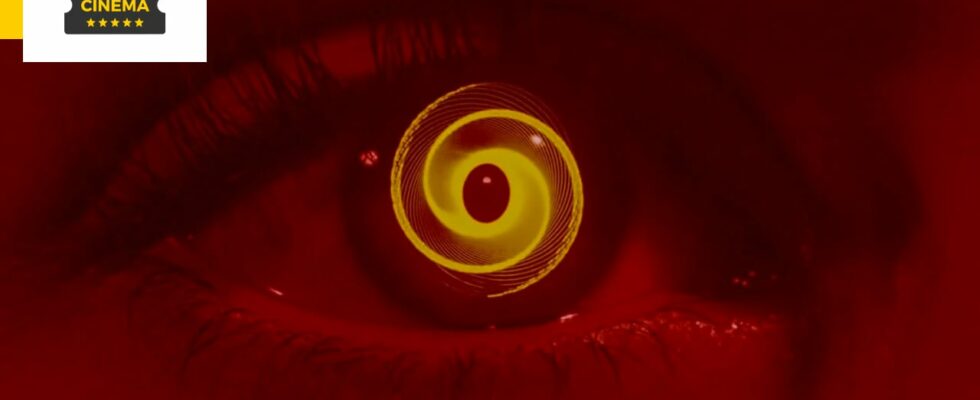Hypnotic and fascinating, the opening credits of Alfred Hitchcock’s “Cold Sweat” are one of the most famous in cinema. And marked the first collaboration between the master of suspense and a legendary Graphic Designer: Saul Bass.
“His credits are not just unimaginative labels – as is the case in many films – they are much more, they are an integral part of the film itself. When his work appears on screen, the film himself really begins. I speak in the present tense, because his work and that of his wife Elaine speak to each of us, no matter our age, no matter our date of birth.”
It is in these more than laudatory and full of admiration terms that Martin Scorsese evoked in the work Saul Bass: A Life In Film & Design the work of an immense artist. That of the inventor of modern credits, still too little known to the general public, who died in 1996 at the age of 75. An artist whose creativity and work are still widely felt today: Saul Bass.
After several internships in various design studios in Manhattan, he began his career as a freelance advertising graphic designer, then moved to Los Angeles in 1946 and founded his own studio, Saul Bass & Associatesin 1950.
It was there that he began to put his talent at the service of Hollywood, creating advertising campaigns for films by Joseph L. Mankiewicz and productions by Howard Hughes.
“The credits, a way of conditioning the public”
The artistic turning point – and the notoriety that goes with it – comes shortly after his meeting with the filmmaker Otto Preminger. The latter entrusted him with the creation of the poster for his film Carmen Jones. This is a first revolution: the artist uses a graphic symbol, in this case a rose enveloped in a flame, where the posters of the time were still content to repeat images from the film. Then Preminger asked him to take care of the creation of the poster as well as the creation of the credits for his other upcoming film, The Man with the Golden Arm, in 1955.
The evocative force of the visual designed by Saul Bass (a stylized arm representing the talents as a musician and poker player of the main character played by Frank Sinatra), as well as his addiction to heroin) is such that during the first of the film in New York, only the logo is displayed, the title is superfluous.
United Artists Detail of the poster for “The Man with the Golden Arm”, created by Saul Bass.
The credits remain. Before Saul Bass, film credits were only obligatory prologues, like rosary lists of names of artistic talents who collaborated on the work. A legal obligation; Nothing more, nothing less.
It is only gradually that some directors will entrust the task of creating credits to artistic directors. When Otto Preminger entrusted this to Saul Bass, the credits moved from the status of a legal obligation to one of the first fields of experimentation in moving images, or Motion Design.
Below, the opening credits of the film The man with the golden armand its famous jazzy music by Elmer Bernstein…
Collaboration with Alfred Hitchcock
The person concerned had a very clear vision of his work: “For the average audience, the opening credits tell them there’s only three minutes left to eat popcorn. I take that ‘dead’ time and try to do more than just get rid of names that don’t appeal to people. moviegoers. I aim to set the audience up for what’s to come; I make them impatient.
My first thoughts on what a title can do was to set the mood and underlying core of the film’s story, to express that story metaphorically. I saw the credits sequence as a way to condition the audience, so that when the film actually started, viewers would already have an emotional resonance with it.” he said.
Bass has a very refined approach to graphic design, with a modern and edgy style. In his creations, the lines are broken or straight, in recurring ways. Applied to film credits, his sense of composition and typography, his preference for suggestion, and his attraction to geometric abstraction, work wonders.
His work obviously did not fail to catch the discerning eye of Alfred Hitchcock, who entrusted him with the creation of the credits for some of his most famous works. The extraordinary opening credits of Cold Sweat, for starters.
See again below…
Creation offering a perfect combination between the shots of Kim Novak’s beautiful eyes, the no less hypnotic musical theme by Bernard Herrmann, and all the work on typography and animations carried out by Saul Bass.
Little icing on the cake of anecdotes, the famous hypnotic spirals visible in the sequence are the work of the artist John Whitney Sr. Musician and experimental filmmaker, the latter is considered the father of computer-assisted image design, and continued his collaboration with Saul Bass until 1961.
Saul Bass insisted that the spirals in the credits, which represent algebraic spirals, had to be precise and not drawn freehand. John Whitney Sr used a huge machine to design them. A sort of mechanical computer, which was an anti-aircraft gun target locking system designed during the Second World War, and which weighed a whopping 350 kg. It also took no less than five men to handle it. Combined with a Wave pendulumthis is what allowed him to create these perfect spirals.
Still, Bass’s work on the credits of Cold sweat left a lasting mark on Scorsese’s retina and cinephilic memory, as mentioned above. To the point that he confided to him, after having produced that of Affranchis in 1990, the credits of its remake Nerves on edge, including the tribute to Cold sweat is obvious (even the music, originally due to Bernard Herrmann, but adapted and re-orchestrated by his disciple Elmer Bernstein).
